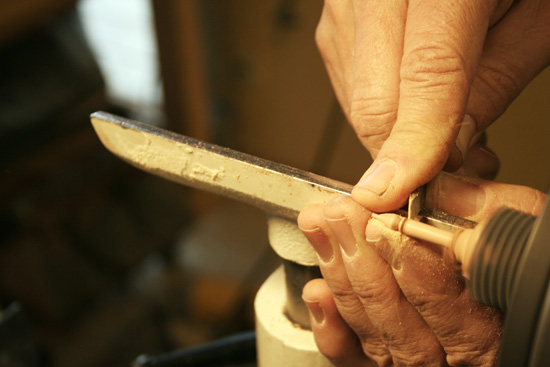The turning studio’s long corridor creates a hallway of wooden parts, lathe stations and the symmetrical objects turned on them. Michael Mocho is quietly playing music as we walk into the studio. A few days earlier Michael stood here and described his work in terms of its detail and ability to sustain the viewer’s attention. To use the term viewer though, might be to passive. During his residency, Michael has focused on making intimate gifts that captivate their recipients.
BIO
Michael Mocho has been working with wood full-time since 1976. In addition to designing and building furniture, sculpture, and architectural millwork, he is an experienced teacher, luthier, and woodturner, and is looking forward to new explorations that combine turned forms and bent wood.
Carey: Would you talk about the significance of an intimate gift experience, and how you think that translates into your work, or woodworking in general?
Michael: My background has been mostly in the context of furniture making, though I’ve worked for sculptors, made musical instruments and done pattern making, among other things. I’ve made my living selling my skills as a technician. When it came to using my own work to make gifts for friends, I had all these cut offs left over from projects. I started making containers, even back when I was in high school. They take different forms, and I think the whole act of giving someone a gift is in the giving, not in the gift itself. Gifts are transient. Sometimes I kind of imagine a person reaching into a dumpster or a landfill and finding a piece of my work and pausing for a second, and thinking, “Huh? Yeah…that’ll burn.” (We Chuckle)
All we really have sometimes are the moments that are significant to us, so we have to consider what makes something significant. I’m hoping these gifts can serve a purpose between people where one might think about what’s inside, or really, what’s important.
Carey: If it’s about that transition, those ephemera of gift giving, could you talk about your fascination with these tedious objects?
Michael: There’s a certain absurdity to small objects. To me they provide an opportunity that reminds us there are contradictions in all of us, and if we don’t embrace those contradictions we run into trouble. It’s this idea: Making something so small, or so precious has to do with the extremes of pushing myself, the difficulty in the craft. It’s like walking a tight rope, I think some people are drawn to it and some aren’t.
Carey: How do you think the idea of making something over and over and over again with one specific object in mind effects your work? Are you pushed more toward that compulsion, or do you stray away from that style of work?
Michael: I think I’ve become really selective, especially in relation to proportion. For me, it’s no longer about how to cut the wood, it’s where. I used to do a lot of rock climbing, and in some ways it kind of parallels that. It’s like a puzzle, in terms of repetition, yeah you get better at the technique, your skill improves…hopefully. But there’s also looking at the work from a new angle. You have to be willing to make work that isn’t so hot, to get to the good stuff, because it’s never going to hit the bulls eye every time. There’s an expression that Wendell Castle uses, he says, “If you hit the bulls eye every time, the target may be to close.”
More of Michael’s work can be seen on his website at michaelmocho.com






